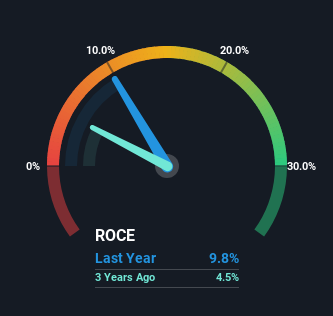- India
- /
- Entertainment
- /
- NSEI:PFOCUS
Prime Focus (NSE:PFOCUS) Is Looking To Continue Growing Its Returns On Capital
If we want to find a potential multi-bagger, often there are underlying trends that can provide clues. Ideally, a business will show two trends; firstly a growing return on capital employed (ROCE) and secondly, an increasing amount of capital employed. This shows us that it's a compounding machine, able to continually reinvest its earnings back into the business and generate higher returns. With that in mind, we've noticed some promising trends at Prime Focus (NSE:PFOCUS) so let's look a bit deeper.
What Is Return On Capital Employed (ROCE)?
If you haven't worked with ROCE before, it measures the 'return' (pre-tax profit) a company generates from capital employed in its business. The formula for this calculation on Prime Focus is:
Return on Capital Employed = Earnings Before Interest and Tax (EBIT) ÷ (Total Assets - Current Liabilities)
0.098 = ₹5.0b ÷ (₹68b - ₹17b) (Based on the trailing twelve months to June 2023).
So, Prime Focus has an ROCE of 9.8%. On its own that's a low return, but compared to the average of 7.1% generated by the Entertainment industry, it's much better.
Check out our latest analysis for Prime Focus

While the past is not representative of the future, it can be helpful to know how a company has performed historically, which is why we have this chart above. If you're interested in investigating Prime Focus' past further, check out this free graph of past earnings, revenue and cash flow.
What Can We Tell From Prime Focus' ROCE Trend?
Even though ROCE is still low in absolute terms, it's good to see it's heading in the right direction. The numbers show that in the last five years, the returns generated on capital employed have grown considerably to 9.8%. The company is effectively making more money per dollar of capital used, and it's worth noting that the amount of capital has increased too, by 160%. This can indicate that there's plenty of opportunities to invest capital internally and at ever higher rates, a combination that's common among multi-baggers.
In another part of our analysis, we noticed that the company's ratio of current liabilities to total assets decreased to 24%, which broadly means the business is relying less on its suppliers or short-term creditors to fund its operations. This tells us that Prime Focus has grown its returns without a reliance on increasing their current liabilities, which we're very happy with.
The Key Takeaway
In summary, it's great to see that Prime Focus can compound returns by consistently reinvesting capital at increasing rates of return, because these are some of the key ingredients of those highly sought after multi-baggers. Since the stock has returned a solid 68% to shareholders over the last five years, it's fair to say investors are beginning to recognize these changes. In light of that, we think it's worth looking further into this stock because if Prime Focus can keep these trends up, it could have a bright future ahead.
On a final note, we've found 2 warning signs for Prime Focus that we think you should be aware of.
While Prime Focus isn't earning the highest return, check out this free list of companies that are earning high returns on equity with solid balance sheets.
New: Manage All Your Stock Portfolios in One Place
We've created the ultimate portfolio companion for stock investors, and it's free.
• Connect an unlimited number of Portfolios and see your total in one currency
• Be alerted to new Warning Signs or Risks via email or mobile
• Track the Fair Value of your stocks
Have feedback on this article? Concerned about the content? Get in touch with us directly. Alternatively, email editorial-team (at) simplywallst.com.
This article by Simply Wall St is general in nature. We provide commentary based on historical data and analyst forecasts only using an unbiased methodology and our articles are not intended to be financial advice. It does not constitute a recommendation to buy or sell any stock, and does not take account of your objectives, or your financial situation. We aim to bring you long-term focused analysis driven by fundamental data. Note that our analysis may not factor in the latest price-sensitive company announcements or qualitative material. Simply Wall St has no position in any stocks mentioned.
About NSEI:PFOCUS
Prime Focus
Provides integrated media services primarily in India, the United Kingdom, the United States, Canada, Australia, and internationally.
Adequate balance sheet with low risk.
Similar Companies
Market Insights
Community Narratives




